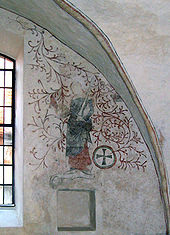St. Margarethen Church (Vernawahlshausen)
The St. Margarethen Church is the oldest surviving building in the center of the village of Vernawahlshausen , a town in the Hessian community of Wesertal in the Kassel district .
history
From the partly Romanesque construction it can be concluded that the church was built before the village was first mentioned in a document. According to tradition, there was an even older predecessor building, a chapel allegedly built in the 10th century by monks from Corvey Monastery , which was consecrated to Saint Margaret of Antioch .
The patrons of the church were the dukes of Braunschweig until 1293. Through an exchange of territory, the patronage came via the chapel to the Lippoldsberg monastery . In 1538, following the introduction of the Reformation in Hesse and the dissolution of the Lippoldsberg monastery, it came into the possession of the then Hessian Landgrave Philipp .
The Protestant parish of Vernawahlshausen has been an independent parish since the Reformation. The names of the pastors from 1527 to 1993 are listed on an oak panel inside the St. Margarethenkirche.
The baroque half-timbered tower tower dates from 1744.
Sanctuary
In the parish records, the oldest part of the church is the square choir or chancel. It is believed that it was built as a Romanesque choir with a cross cap vault around 1100. Medieval frescoes were discovered in it in 1955 during renovation work . They are said to have been whitewashed with lime paint in 1605 on the instructions of Landgrave Moritz (nickname "the scholar"), who was then ruling in Hessen-Kassel and was a follower of the Calvinists .
Frescoes
In terms of art history, the frescoes are classified in specialist literature from "Romanesque to late Gothic". However, investigations in the run-up to the renovation of the frescoes in autumn 2005 and winter 2006 showed that all motifs are of late Gothic origin (15th century).
The frescoes mostly depict motifs from biblical history.
Historical organ
The organ was built in the first half of the 19th century by the organ building company Johann Dietrich Kuhlmann (Gottsbüren). The case is probably older. The instrument has twelve registers , divided between a manual and the pedal .
|
|
|||||||||||||||||||||||||||||||||||||||||
- Coupling : Coppel (pedal coupler as a train)
literature
- Thorsten Quest, Uta Schäfer-Richter: Village life. The history of the villages Lippoldsberg and Vernawahlshausen. Published by the municipality of Wahlsburg in 1989. Die Werkstatt publishing house, Göttingen.
Web links
- Bridge to the neighbor - the St. Margarethen Church in Vernawahlshausen
- Churches in Vernawahlshausen - Information from the Wahlsburg community about St. Margarethen Church
Individual evidence
- ↑ Thorsten Quest, Uta Schäfer-Richter: Village life. The history of the villages Lippoldsberg and Vernawahlshausen. Page 12: "Probst Konrad, who resided from 1198 to 1224 according to Lippold Mountain, undertook a barter transaction in which he a steward Konrad one hooves country in Walshusen handed."
- ↑ a b Info from the Evangelical Parish Vernawahlshausen about the St. Margarethen Church.
- ↑ More information on the organ of St. Margarethen Church
Coordinates: 51 ° 37 ′ 31 ″ N , 9 ° 37 ′ 18 ″ E



